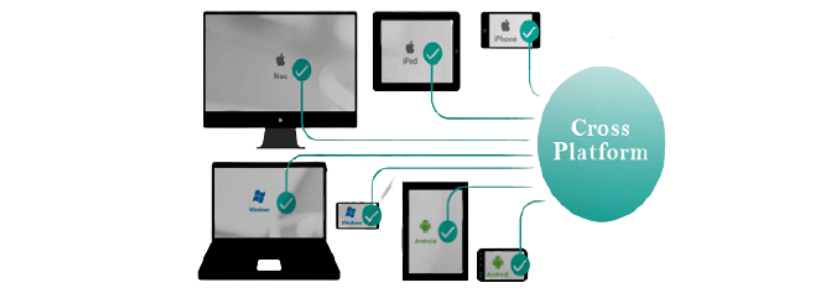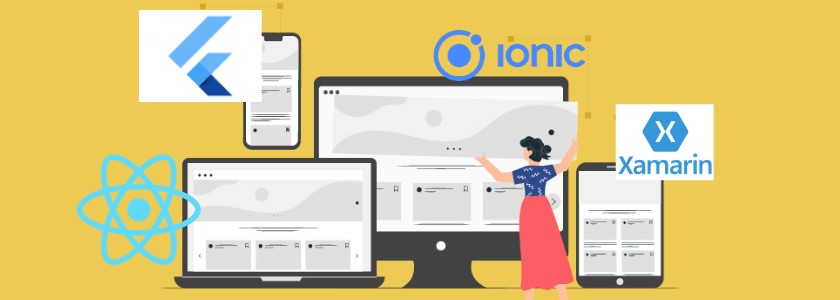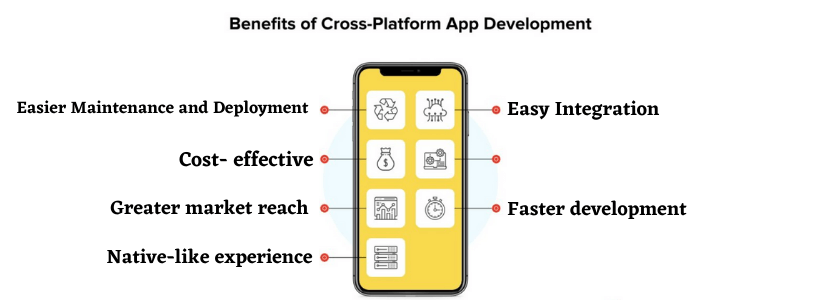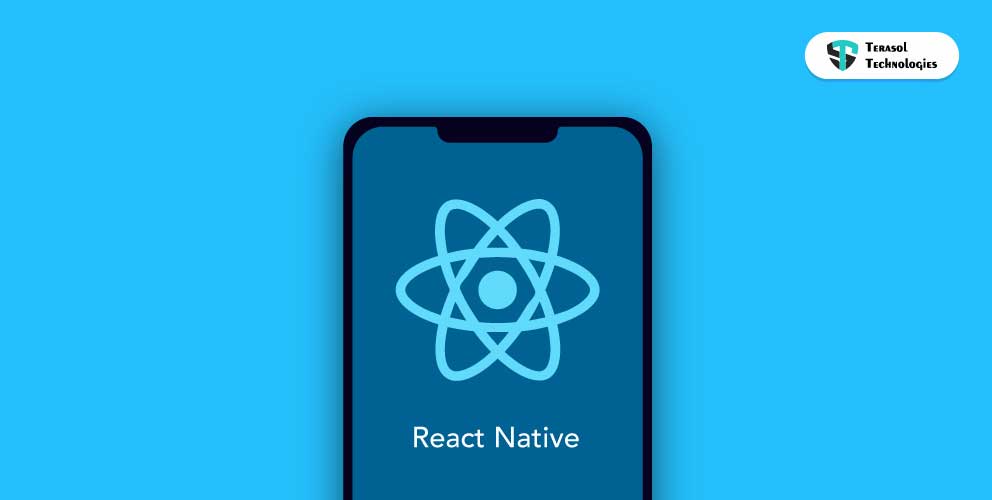4 Best Cross Platform Mobile App Development Technologies
For many organizations in a variety of industries, mobile apps have become a necessity. Such apps must work well across several platforms, including iOS, Android, and Windows.
You can swiftly and cost-effectively design such products using these best cross-platform mobile development technological approaches.
One of the most sought-after terms in the mobile app business is cross-platform mobile app development. Everyone enjoys coding and customizing smartphone apps.
However, can we keep the same time and, most importantly, the same code?
Yes, writing once and running everywhere is no longer just a trend, but a necessity in today's environment. It is where the cross-platform development applications come into play.
When contemplating a cross-platform alternative, a new technology that the team will need to master should never be overlooked.
If you're a React-based web store, you should start with React Native; if you're not using React, does Cordova make more sense?
What about a progressive web app? Perhaps the best approach is to use J2ObjC or Kotlin/Native.
Check out Flutter if learning a new language to share 100% of your code sounds like fun. The argument is that where you come from may influence where you go next.
One of the best mobile application projects and workflows among SMEs and larger companies is the capacity to construct strong, secure, performance-heavy, cross-platform mobile applications.
Let's know about the best technologies for cross-platform app development, as well as the Pros and Cons of creating multiplatform solutions.
What Is Cross-Platform Mobile App Development?

The term cross-platform mobile app development or hybrid mobile app development describes a technique that allows developers to create a mobile solution that is compatible with many operating systems and platforms at the same time (Android, iOS, Windows).
It is an application technology that enables businesses to swiftly develop and deploy mobile assets across a range of platforms without having to recode for each native Operating System (OS) and platform.
Developers create cross-platform applications using intermediate programming languages such as HTML, JavaScript, and CSS, which are not native to devices or operating systems. Apps are then packaged and integrated into platforms using native containers.
How can you tell if cross-platform mobile development is a good fit for your company?
With the rapid advancement of technology and the availability of various operating systems, deciding which platform to use for your workplace application can be difficult.
Let's make things a little easier for you.
Platform:
You must select if your software will be available on a single operating system or several operating systems. If you want to reach a broader audience made up of people who use different platforms, cross-platform development is the way to go.
The complexity of the app:
The only approach to handle this is to decide whether you want to create a basic app with an MVP development or whether you want to launch a full-fledged app with platform-specific features.

Development time and cost:
Building distinct applications for different platforms necessitates a larger number of developers, which could cause a newly minted entrepreneur to go over budget early on. However, choosing the cross-platform strategy will result in you outsourcing a smaller but equally professional staff, which is a time- and cost-effective choice.
So, now we know how to check if it is the right choice or not, it's time for the best technologies for cross-platform app development.
4 Best for Cross-platform Mobile App Development Frameworks
The process and deliverables of software development can differ depending on the tool you choose. It is critical to select the appropriate framework. We've put together a list of the top four most popular cross-platform app development frameworks.
1. React Native
One of the most popular cross-platform mobile development frameworks is React Native. It's built with React, a best-in-class JavaScript toolkit for developing user interfaces, and it's optimized for most mobile devices. The beauty of React Native is that you can design cross-platform solutions using a universal JavaScript language as well as native platform-specific languages like Java, Swift, or C.
Takeaways from React Native:
- It speeds up the reach of your app in app stores.
- Advanced web technologies are used to create an intuitive and modular architecture.
- Community-driven
2. Ionic
Ionic is a robust HTML5 SDK that enables you to create native platform apps using advanced technologies like HTML, CSS, and Javascript. Ionic comes with a robust range of features and tools, including native-style mobile UI elements and layouts, as well as support for material design. The Ionic framework allows developers to create apps for many platforms, including Android, native iOS, desktop, and online, all from a single code base.
Takeaways from Ionic:
- It comes with pre-designed elements, fonts, interactive paradigms, and fantastic themes.
- This framework is simple to use and comprehend.
- It makes use of APIs like JSX, TypeScript, Virtual DOM.
3. Xamarin
Xamarin is a popular open-source framework for creating hybrid mobile apps that are free to use. Xamarin-based solutions are cross-platform interoperable and deliver the same performance and user experience as native solutions. Xamarin also supports languages like C#, F#, and the Razor template engine, which is complemented by the.NET framework and is available as part of Visual Studio under the MIT license.
Takeaways from Xamarin:
- Because it has a minimal disc effect, it is easy to install.
- Amazing visual experience for Android and iOS.
- Automatic Android SDK installation.
4. Flutter
Another open-source cross-platform app platform. Flutter is all about creating dynamic and fast mobile apps. Developing high-quality standard apps that are widely approved by the developer community. The platform creates user interfaces that reduce code length, making the app development process easier. Flutter app development is used to create well-known apps such as Google Ads, Alibaba, and others.
Takeaways from Flutter:
- It's best for developers that want to create iOS and Android apps with a single codebase.
- Material Design with a large number of options for customization.
- With OEM widgets, you can create designs that are focused on your brand.
A few Others
While every development business can and should use the top-tier cross-platform mobile development tools, there are several other recommended tools to use, albeit those that are not the top pick for cross-platform development. SDKs like Corona and strong gaming frameworks like Unity are examples.
Benefits of Cross-Platform Development

Let's pretend you've asked yourself all of the above questions and determined that native development isn't your cup of tea. Because of developing technology, multiplatform mobile app development is becoming more dynamic and appealing to developers.
Faster development
It's easier to create apps for several platforms in a shorter amount of time. Because cross-platform apps are built on a single codebase, they take less time to develop than native apps, which take the same amount of time to develop for each operating system.
Cost-effective
Creating separate native apps for each platform is costly, but a hybrid app employs a single sharable code, allowing you to stay on budget. Code reuse reduces development time and costs. When you outsource a cross-platform app developer or company to modify the program, unlike native apps, they simply use reusable scripts, which reduces costs.
Easy Integration
Cloud Integration that works flawlessly Make the best decision possible. It's simple to integrate cross-platform apps with the cloud platform thanks to a single code source, which improves compatibility and makes it easier to maintain apps in the cloud.
Greater market reach
Companies who wish to appeal to users of a variety of mobile devices and expand their market reach should consider hybrid development.
Easier Maintainance and Deployment
A single and universal app is compatible with running on all platforms in cross-platform app development. As modifications are made, this makes it easier to maintain and deploy code. Updates can be synchronized across all platforms and devices in real-time.
Native-like experience
With a single codebase, you can create a native-like user experience. When all of the advantages of cross-platform apps are considered, as well as the development process, timeline, and cost, it is reasonable to conclude that it provides a superior user experience when compared to hybrid and native apps.
The best cross-platform mobile app development platforms, for the most part, provide a native-like user experience, features, and functionality.
Examples of companies using Cross-platform Technologies
- Instagram: The popular social media app Instagram is made React Native.
- Bloomerang: Bloomerang is a website developed using React Native that features news from across the world and is compatible with any phone operating system.
- Google Ads: It is developed using Flutter. It's also incredibly adaptable, working in a variety of languages, formats, and time zones.
- BBC Good Food: A website built from Xamarin. It is all about good food recipes that everyone can enjoy.
Conclusion
To be competitive, most businesses now construct mobile versions of their websites. Businesses should use cross-platform development as it helps them to quickly produce reliable applications that are compatible with all customer devices.
Which of the mentioned cross-platform mobile app development frameworks is the best fit for you?
The simple answer is that it depends on the functional requirements of the business and the app you wanted to build.
Feel free to contact us and consult a qualified and experienced cross-platform mobile app development expert and make an informed decision.


